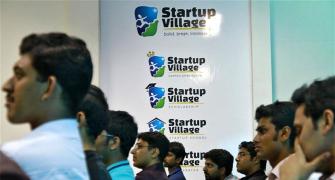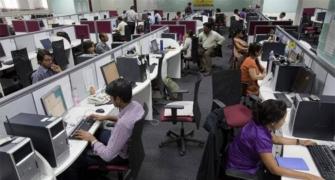Despite lay-offs and the threat of automation, the industry will continue to be an important driver of growth in employment and GDP, says Ashok Soota.

There has recently been a lot of angst about the Indian information technology (IT) industry. The anxiety has centred around two themes:
Is the $150-billion industry, which is about seven per cent of Indian gross domestic product (GDP), now heading for a period of stagnation?
The impact of the above and other global developments such as visa restrictions on the job market for IT professionals, considering that the industry employs four million professionals and indirectly generates many more jobs.
The anxiety tends to breed cynicism as witnessed by the response to a question in The Economic Times on May 15: “Are laid-off techies paying the price for IT cos’ inability to foresee the future?” As is often the case with such questions from ET, which lead you to a favoured response, a resounding 78 per cent replied “yes” indeed.
Even more surprising, though, is a masthead quote in The Business Standard on May 19 from Rajat Gupta, the former head of McKinsey: “The Indian infotech industry ‘rightly’ should be in ‘panic’ mode, as it has not kept pace with the fast-changing innovation... Code writing and testing is the most inefficient industry that existed.”
I consider both the question and the response to the ET question cynical because the people who have been let go constitute mostly between 0.5 per cent and one per cent of the workforce of larger companies and only in the case of Cognizant it is two to four per cent. All these numbers are within the range of annual “weeding out” to continuously improve the quality of talent.
Gupta, for whom I otherwise have the highest regard, in my view should have known that the IT industry moved beyond cost arbitrage at the turn of the century and has progressively embraced solutions around the latest technologies.
This is reflected in the fact that the Indian IT industry has continued to gain market share. Here we have decline in growth, whereas some of the global leaders have had decline in revenue for multiple quarters.
Let’s take the concern and issues on employment first. At the outset, let me also clarify that the lay-offs have nothing to do with Donald Trump and his visa approach. That impact, if any, will come after appropriate legislation is passed and rules are framed.
There are two sets of opposing forces affecting employment. Of those which reduce employment (but also create fewer higher-level jobs), the leading one is automation.
While IT is increasing automation in virtually every sector, IT itself is getting impacted by automation. Approximately 25 per cent of the jobs in testing, BPO and now infrastructure support are being eliminated by automation and the process will continue.
The creation of cloud-based delivery and support has also transferred some of the work traditionally done by services companies to the main platform providers such as Microsoft and AWS. Finally, there is the stated goal of non-linearity essential for competitiveness of the industry.
Simply put, this means that revenue growth will be faster than employment growth as a result of using productivity tools and outcome-based business models.
Coming now to the forces that are increasing employment of IT professionals, though not all within the IT industry. The first is the new digital economy. Clearly, a large part of new budgets for IT spend is going towards digital solutions.
The technologies driving this are SMAC (social media, mobility, analytics and cloud) plus artificial intelligence/cognitive computing, internet of things and security. Happiest Minds, born as a digital company, derives almost 70 per cent of its business from digital, with web technologies making up the rest.
Older players are striving towards a 25 per cent share from digital. The second force is the creation of new IT-driven, platform-based digital businesses. Hence, you have edutech, fintech, healthtech - you name any business and there is a role for digital technology - be it energy, retail etc.
Finally, there is the entrepreneurial boom globally and most specifically in India. For a company like Happiest Minds, this means that our product engineering has been booming and growing at over 40 per cent annually. New world start-ups, whether e-commerce or even Aadhaar, need to employ a large number of IT professionals apart from what they outsource.
Let us now come to industry growth. Historically, I like to split the industry into three distinct phases. The first was the nineties when the industry grew at a mind-boggling compounded rate of 50 to 60 per cent and this coincided with the period when I was leading Wipro.
This was the peak period of cost arbitrage as the value proposition for offshoring was so high. By 2000, MNCs had woken up to the threat posed by the Indian IT industry. All of them set up large IT centres in India and other low-cost economies. Very soon, distributed development became the norm.
Cost arbitrage as a means of getting business disappeared. This led to the second phase from 2000 to 2010 when the industry grew 30 to 40 per cent based on its move up the value chain and quality of delivery. This phase coincided with my leadership at Mindtree. Finally, the phase of 2011 onwards, which also saw the birth of Happiest Minds.
This is the phase of disruptive technologies and digital transformation. Since the industry by now is gigantic in size, percentage growth was bound to come down to, say, 12 to 15 per cent. Admittedly, the eight per cent growth of last year has come as a big disappointment.
However, many digital transformational projects begin as PoCs and should grow into larger deals. Also, new solutions become possible due to new technologies and the pace of change for such new technologies continues to increase, blockchain and virtual/augmented reality being a few examples.
In conclusion, where do we go from here on both industry growth and employment? On the latter front, many legacy jobs will disappear and new ones appear. Employees will need reskilling and all of them will not be adept at picking up new skills. These people will leave the industry and, hopefully, some of them will add to the entrepreneurial boom.
Nasscom has set a growth target of $350 billion by 2025. This will require a compound average growth rate of 11 per cent. In light of the current growth level, I feel the targets may need to be revisited, but still we should be able to achieve a revenue of $300 billion plus.
I remain confident that whatever the numbers, the IT industry and IT professionals will continue to be an important, though not principal driver, of growth in employment and India’s GDP.
Ashok Soota is executive chairman, Happiest Minds.
Photograph: Reuters










